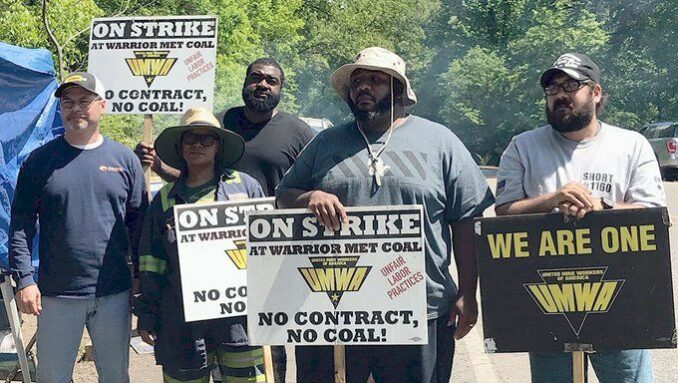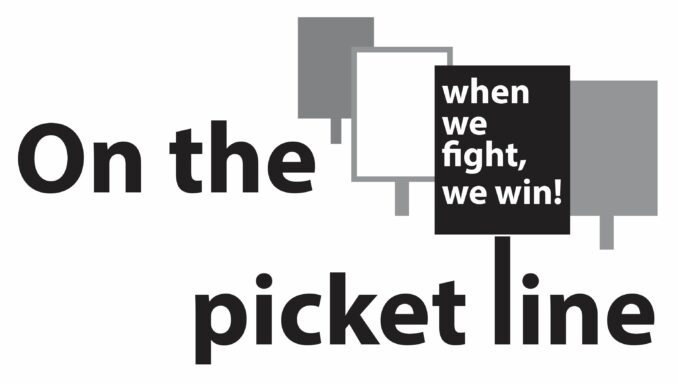On the picket line
What just happened?

In Brookwood, Alabama, United Mine Workers coal miners “hold the line” and continue the strike they began in April 2021.
The past year has been a brutal wake-up call for the working class. The pandemic has killed hundreds of thousands of U.S. workers so far and left many more in a very precarious financial predicament, like the 12 million workers who fell behind on their rent in 2021.
The response of the ruling class to the plight of the worker during the pandemic has ranged from ineptitude to callous disregard. Shareholders and CEOs protected their profit margins rather than the workers who risked their lives to keep the capitalist machine running.
If you were paying attention, you saw workers reach a breaking point and demand their labor leaders be more militant during contract negotiations and push for better pay and benefits. Amazon workers from Bessemer, Alabama, to Staten Island, New York, took on Jeff Bezos and his megacorporation to demand an end to the abysmal working conditions in those warehouses.
For 2021, the Cornell Labor Tracker listed a total of 77 strikes and 116 labor protests in the field of education, including K-12 teachers and university workers. There were 60 strikes at health care institutions across the country. Nurses and other essential hospital personnel walked off the job because of poor staffing that increased the risk of harm to patients. Major manufacturing strikes happened at Kellogg’s, John Deere, Nabisco and Frito-Lay, where workers won better contracts, although advances against union-busting two-tier systems did not go far enough.

Teamster truckers walked off the job and demonstrated the fragility of the just-in-time supply chain model. Gig workers from GoPuff, Uber and Lyft flexed their muscles — as workers who provide essential services — to win concessions regarding safety and wages. Starbucks workers won a historic union election, and grassroots efforts to unionize the coffee chain are spreading.
At the beginning of 2021, Hunts Point Market workers in New York City went on a seven-day strike and won safety concessions and their largest pay raise in decades. The year ended with United Mine Workers at Warrior Met coal mines in Brookwood, Alabama, still on strike after nine months — and with nurses at Saint Vincent Hospital in Massachusetts reaching a tentative agreement with the Tenet corporation, after 300 days on strike and 43 negotiation sessions.
New year, new struggles
The new year begins with a pandemic surge sweeping across the U.S. and the Centers for Disease Control and Prevention downgrading safety protocols, forcing more workers to stay on the job, despite the risk of spreading disease and becoming gravely ill.
For U.S. government leaders, the capitalist economy and corporate profits are the top priority, and workers are disposable in the effort to keep business in business.
How will the labor movement and union leaders respond to these attacks? It had better be with militancy and strength! There is the coming battle at Amazon, after a National Labor Relations Board ruling mandated Amazon must inform its 750,000 U.S. employees that they have a right to organize.
According to a Bloomberg analysis, nearly 200 large union contracts, collectively covering 1.3 million workers, will expire by the end of 2022. The International Longshore and Warehouse Union represents 20,000 dock workers at 29 ports on the West Coast, and its contract with Pacific Maritime Association expires in July. The Teamsters’ Carhaul Division, representing 4,000 car haulers, will negotiate a new contract in May.
The United Steelworkers will be in negotiations representing 30,000 Marathon Petroleum workers and 5,700 workers at Goodyear Tires. Teachers in Los Angeles, Oakland and New York City will be at the bargaining table, as will 19,000 graduate employees at the University of California and 16,000 campus workers and professors at Rutgers University in New Jersey.
Nurses at the University of Michigan Medical Center will see their contract expire this year. These 5,000 nurses have logged 900 unsafe staffing incidents and are treating more COVID-19 patients than ever. The institution made a profit in 2021, following two rounds of layoffs, which left hospital wards dangerously understaffed. Safe staffing-to-patient ratios will surely be on the table when the nurses’ contract expires in June.
The contract for nurses at Temple University Hospital in Philadelphia expires in September. That contract covers the 1,500 RNs and 800 other health care staffers in the Pennsylvania Association of Staff Nurses and Allied Professionals. PASNAP President and Temple Hospital RN Maureen May recently told Fox29 News, “We are in crisis,” with hospitals near capacity due to the pandemic surge. Undoubtedly, the pandemic will be a major factor when PASNAP negotiates with Temple University Hospital.
Workers need to recognize their collective power. If the pandemic has one lesson, it is that the worker, not the CEO, is essential. That has been demonstrated time and time again in industry after industry. It is time to seize the moment!
Let’s resolve that 2022 will be the year we build a workers’ world.

